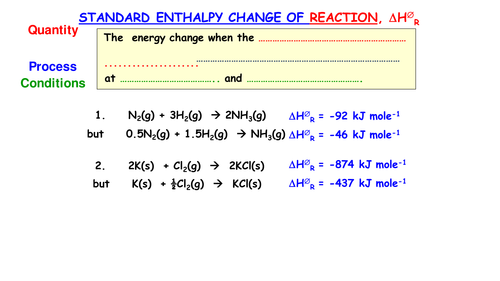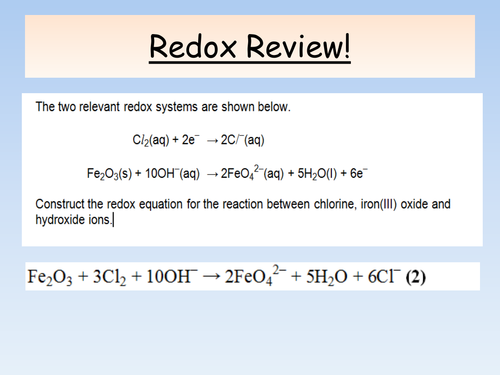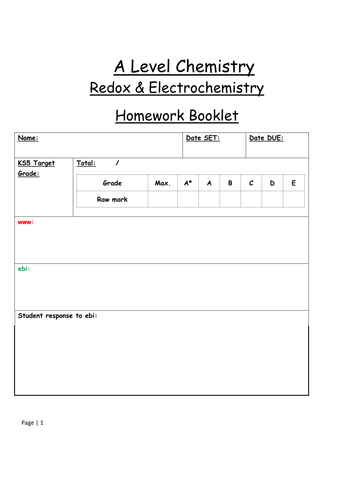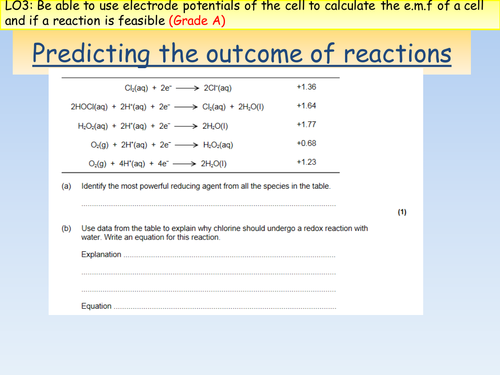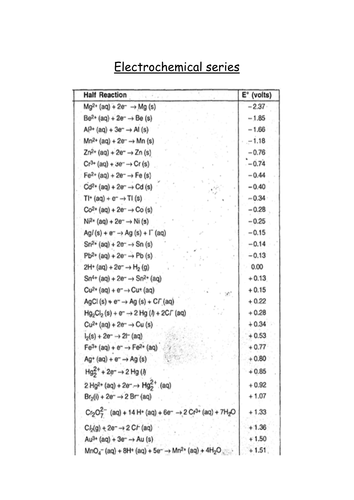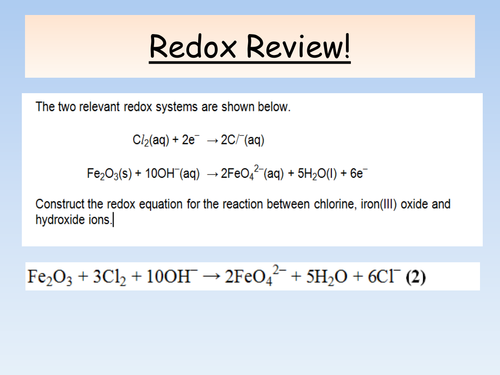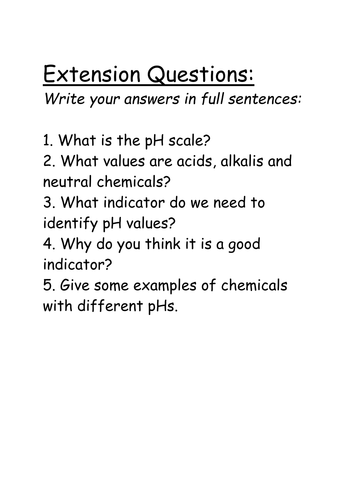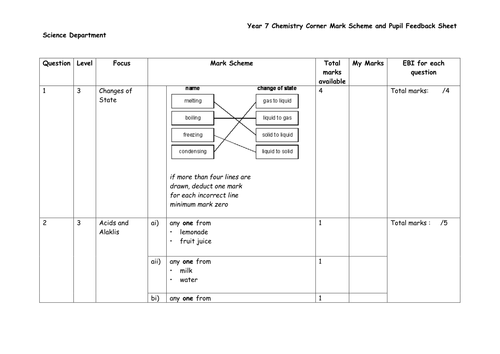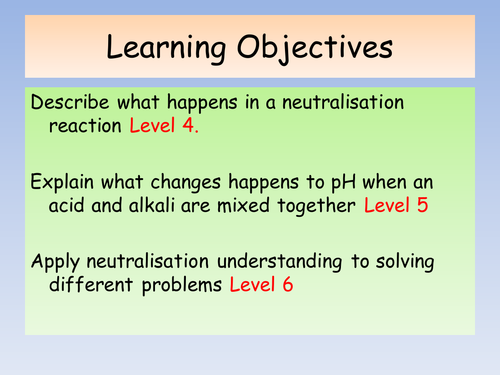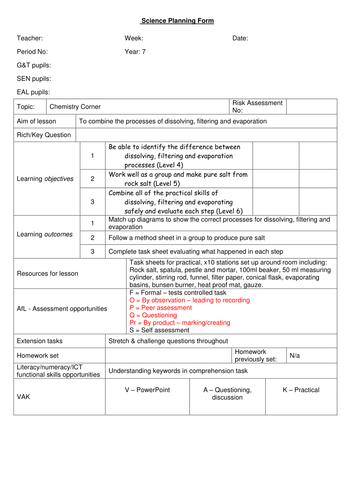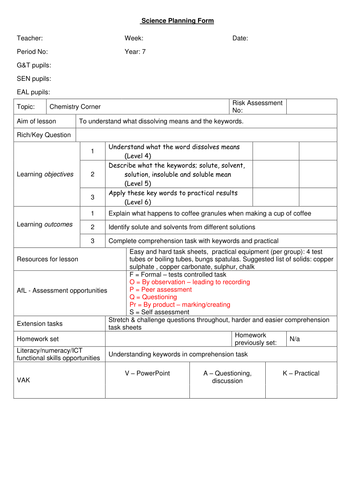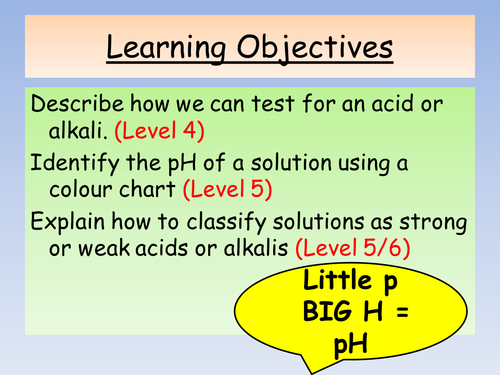
50Uploads
22k+Views
8k+Downloads
All resources

New AQA A Level Chemistry Thermodynamics Lesson 1
This lesson is used as an initial recap on the Year 12 content on Energetics before starting the Thermodynamics topic fully from the new AQA A Level Chemistry topic 3.1.8
The powerpoint includes a variety of different energetics questions from Year 12 which can be distributed around the room as a circus of self assessment questions. Answers and mark schemes are included for each question, definition etc. The questions cover Enthalpy of formation, combustion and reaction, Calorimetry questions, Average bond enthalpies and Hess Cycles for formation and combustion.
Also included is a simple worksheet on exothermic and endothermic reactions which can be used as part of the circus as well.
At the end of the lesson students can highlight calculation areas they need to review from Year 12 from Energetics prior to starting the Thermodynamics topic. Also included is a list of the required definitions needed to know for the Thermodynamics topic which can be handed to students ready for pop quiz definition tests throughout the topic.

New AQA A Level Chemistry Whole Topic Electrode Potentials and Electrochemical Series
This bundle is for lessons which cover all of the 3.1.11 content for the new AQA A Level Chemistry topic on Electrode Potentials and Electrochemical Series.
The bundle includes 4-5 lessons worth of content including:
Introduction to electrochemical cells
Daniell Cell practical
Calculating emf values
Predicting if a reaction is feasible based on emf values
Standard Hydrogen Electrodes
Electrochemical Series
Fuel cells including Hydrogen Oxygen Fuel cells
Exam Question assessment booklet with mark scheme

New AQA A Level Chemistry Electrochemistry Assessment booklet
This assessment booklet follows the new AQA A Level Chemistry specification 3.1.11
This can be used as either a homework booklet to accompany the topic or set as an end of topic assessment booklet. I used it as a homework booklet and it comes with a front cover sheet with room for www and ebi comments and mark scheme.
Extra exam questions have also been uploaded for this topic as well.

New AQA A Level Chemistry Lesson Fuel Cells
This lesson follows the new AQA A Level Chemistry specification 3.1.11.2
The lesson covers:
Recap on predicting if a reaction is feasible based on emf values
Exam question on predicting if a reaction is feasible
Examples of reversible and non reversible reactions and writing overall equation and calculating overall emf values.
Comparing advantages and disadvantages of reversible and non reversible fuel cells
Hydrogen oxygen fuel cell, youtube clips, how it works and equations
Hydrogen oxygen fuel cell diagram can be printed to A3 and annotated.
Advantages and disadvantages of hydrogen oxygen fuel cell

New AQA A Level Chemistry Electrochemical Series and Standard Hydrogen Electrode
This lesson follows the new A Level AQA Specification 3.1.11.1 on Standard Hydrogen Electrode and Electrochemical Series
The lesson covers:
The role of the SHE
How changing conditions can affect electrode potentials
Electrochemical series and trends
Predicting if a reaction is feasible based on electrode potentials

New AQA A Level Chemistry - Redox and Introduction to Electrochemical Cells
This lesson follows the new AQA A Level Specification Electrode Potentials and Cells 3.1.11.1
The lesson content covers:
Electrochemical cells and the role of the salt bridge
Daniell Cell Practical sheet (can be used as required practical 8)
Large cell diagram can be printed onto A3 and labels added
How to calculate electrode potentials
How to draw conventional representations of cells

New OCR A Level Chemistry Specification Lesson - Properties of Alcohols
This powerpoint covers properties of alcohols which would take one lesson's worth of content. The powerpoint covers:
Boiling point, Solubility and Volatility linked to hydrogen bonding of alcohols
Graph drawing task to illustrate BP of alcohols vs alkanes
Classifying alcohols into primary, secondary and tertiary alcohols
Snap plenary task for alcohols.

New AQA A Level Chemistry Homework Booklet - Esters, Acid Chlorides and Acid Anhydrides
This homework booklet can be handed out at the start of the Carboxylic Acid and Derivatives section ( 3.3.9) of the New AQA A Level Chemistry Specification.
The mark scheme for the homework booklet is included as well. The homework booklet includes various exam questions both multiple choice and longer mark answer questions which cover the specification number above as well as the assessed practicals 10a and 10b.

New AQA A Level Chemistry lesson - Acyl Chlorides
This lesson introduces the key ideas of Acyl Chlorides and will cover one lesson's worth of content. The powerpoint covers:
IUPAC rules for naming acyl chlorides
The 4 different reaction processes that acyl chlorides undergo.
The products and reactants needed for the 4 different acyl chloride reactions
The reaction mechanism for Acyl Chlorides is not covered in this single lesson powerpoint but another resource. This lesson is based on the New AQA A Level Chemistry specification.

New AQA A Level Chemistry Lesspon - Fats & Oils
This powerpoint and practical sheet covers two lessons worth of content. The powerpoint covers:
How an ester bond forms a fat and oil.
Melting point of fats and oils and how they can be used to make soap.
How Biodiesel is formed and why it isn’t 100% carbon neutral.
Practical instructions to make soap using caster oil and sodium hydroxide (as well as an extra practical making detergent)
This powerpoint has been made following the new AQA A Level Chemistry specification.

New AQA A level Chemistry Specification - Carboxylic Acids & Esters Lesson
This powerpoint would cover easily 2 lessons worth of content which covers:
IUPAC rules for naming carboxylic acids and esters.
Reactions of carboxylic acids
Forming esters from carboxylic acids and alcohols
Acid & Base Hydrolysis of esters
Mini practical instructions to make test tube esters.
This powerpoint is following the new A Level AQA Specification.

Chemistry Corner KS3 Year 7 Topic - Lessons 6-11
This bundle is for half of the topic (Lessons 6-11) as there are too many resources for me to upload the whole topic as a bundle, so I'm having to sell them as two separate bundles.
Lessons 6-11 cover:
Acids & Alkalis
Making your own indicator
Neutralisation reactions
Dissolving
Filtering
Evaporation
This scheme of work was made when KS3 Levels were used, so you may need to amend the levels according to your own assessment criteria used for KS3.

Chemistry Corner KS3 Year 7 Topic - Lessons 1-5
This bundle is for half of the topic I made for KS3 Year 7 called Chemistry Corner (I could only upload half of the lessons so this is for half of the topic, as there are so many resources I've had to split them into two bundles!)
The first five lessons cover:
Solids, liquids and gases
Changes of state
Properties of metals
Simple Chemical reactions
Acids and Alkalis
This scheme of work was made when KS3 Levels were used, so you may need to amend the levels according to your own assessment criteria used for KS3.

Chemistry Corner KS3 Year 7 Topic - End of Topic Test & Progress Planner
This is the end of topic assessment for the Chemistry Corner scheme of work.
There is also a front cover sheet using teacher and student assessment boxes for www and ebi. I have also included the progress planner to show the overall structure of the topic that students can stick into their books.
There is also a mark scheme and raw mark to level converter, however this scheme of work was made when KS3 Levels were used, so you may need to amend the levels according to your own assessment criteria used for KS3.

Chemistry Corner KS3 Year 7 Topic - Neutralisation Reactions
This is the eighth lesson in a topic I made called Chemistry Corner for KS3 Year 7.
This lesson includes a powerpoint on introducing neutralisation reactions using a rainbow fizz demonstration, general word equations, students doing their own mini neutralisation reaction, neutralisation problems such as nettle stings etc.
This scheme of work was made when KS3 Levels were used, so you may need to amend the levels according to your own assessment criteria used for KS3.

Chemistry Corner KS3 Year 7 Topic - Evaporation
This is the eleventh lesson in a topic I made called Chemistry Corner for KS3 Year 7.
This lesson includes a powerpoint on identifying dissolving, filtering and evaporation techniques from diagrams, what happens in evaporation and then a final group practical. This is a rock salt challenge so students are assessed on their group practical skills as well as their answers to the evaporation questions.
This scheme of work was made when KS3 Levels were used, so you may need to amend the levels according to your own assessment criteria used for KS3.

Chemistry Corner KS3 Year 7 Topic - Filtering
This is the tenth lesson in a topic I made called Chemistry Corner for KS3 Year 7.
This lesson includes a powerpoint reviewing solvent, solute and solution from the previous lesson, introducing the key words filtrate and residue, mini plenary assessment worksheet and a desert island practical problem using filter paper and labelling a filtration practical.
This scheme of work was made when KS3 Levels were used, so you may need to amend the levels according to your own assessment criteria used for KS3.

Chemistry Corner KS3 Year 7 Topic - Dissolving
This is the ninth lesson in a topic I made called Chemistry Corner for KS3 Year 7.
This lesson includes a powerpoint on what dissolving means and explanations about key words solvent, solute and solution, a dissolving practical, comprehension tasks reviewing the lesson and key words (differentiated options for the task)
This scheme of work was made when KS3 Levels were used, so you may need to amend the levels according to your own assessment criteria used for KS3.

Chemistry Corner KS3 Year 7 Topic - Making indicator
This is the seventh lesson in a topic I made called Chemistry Corner for KS3 Year 7.
This lesson includes a powerpoint on a high five review task for acids and alkalis, making indicator from red cabbage, testing red cabbage indicator to identify whether a mystery solution is an acid or alkali.
This scheme of work was made when KS3 Levels were used, so you may need to amend the levels according to your own assessment criteria used for KS3.

Chemistry Corner KS3 Year 7 Topic - Acids and Alkalis
This is the sixth lesson in a topic I made called Chemistry Corner for KS3 Year 7.
This lesson includes a powerpoint on what an acid and alkali are, pH scale, testing a circus of liquids
and recording results, extension questions and a homework sheet on acids and alkalis.
This scheme of work was made when KS3 Levels were used, so you may need to amend the levels according to your own assessment criteria used for KS3.

